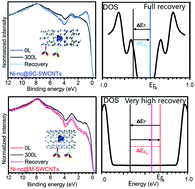Reversible changes in the electronic structure of carbon nanotube-hybrids upon NO2 exposure under ambient conditions†
Abstract
The properties of single-walled carbon nanotubes provide them with enormous potential as gas sensors but true effectiveness can really be expected if their interaction with sensing targets can be controlled and their recovery is granted. It is shown here how metallicity-sorted tubes filled with nickel(II) acetylacetonate in the molecular form, and also subsequently transformed into metal clusters encapsulated in the hollow core, are able to unfold two major challenges: tuning the gas–tube interaction and achieving the desorption of NO2 at ambient temperature. Aiming at the control of the sensitivity of the nanotubes to NO2 at room temperature, by making use of time resolved photoemission we observed that in semiconducting nanotubes the chemical potential is pinned inside their energy gap shifted to the onset of the conduction band when filled with nanoclusters. This shows that cluster filling is a key to high sensitivity, opening the possibility for a very high desorption at ambient temperature.



 Please wait while we load your content...
Please wait while we load your content...